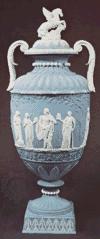- Wedgwood ware
-
Creamware appealed to the middle class because of its high quality, durability, and affordability. Black basaltes (from 1768), unglazed stoneware of fine texture that was ideal for imitating antique and Renaissance objects, appealed to antiquarians. Also in the Neoclassical tradition was jasperware (from 1775), a white, matte, unglazed stoneware that could be stained. White ornaments were applied to the coloured body, achieving the look of an antique cameo. With the help of such artists as John Flaxman, Wedgwood copied many antique designs. Production of fine Wedgwood ware continues to the present day.
 Wedgwood jasperware vase, Staffordshire, England, c. 1785; in the Victoria and Albert ...By courtesy of the Victoria and Albert Museum, London; photograph, Wilfrid WalterEB Inc.
Wedgwood jasperware vase, Staffordshire, England, c. 1785; in the Victoria and Albert ...By courtesy of the Victoria and Albert Museum, London; photograph, Wilfrid WalterEB Inc.* * *
English stoneware, including creamware, black basaltes (basaltes ware), and jasperware, made by the Staffordshire factories originally established by Josiah Wedgwood (Wedgwood, Josiah) at Burslem, at Etruria, and finally at Barlaston, all in Staffordshire. In the decade of its first production, the 1760s, Wedgwood ware attained a world market, which it continues to hold. Wedgwood perfected cream-coloured earthenware (which had been improved earlier in the century by other potters) called creamware, or Queen's ware in consequence of royal patronage. Mass-produced, it was nevertheless of high quality, being light, durable, and tasteful both in its shapes and in its decoration, which was often in the popular Neoclassical style. It filled a long-felt need for good tableware that the middle class could afford, and it fixed for two centuries the prevailing taste for variants of cream-coloured domestic ware. Porcelain and tin-glazed earthenware factories both in England and abroad suffered from competition with Wedgwood's creamware. Surviving factories switched from the manufacture of tin-glazed ware, which died out, to the production of creamware. The revolution wrought by Wedgwood in the industry was helped by further factors: the act of 1763 that extended the Liverpool turnpike road to Burslem, thereby accelerating the transport both of raw materials from other parts of England and of the wares to their destination; and the invention by John Sadler and Guy Green in Liverpool in 1755 of transfer printing on pottery. Wedgwood purchased the right to use the technique in 1763, enabling the decoration to be done by comparatively unskilled workers. More elaborate and costly Wedgwood services, however, were decorated by hand.While creamware was the staple product, Wedgwood fulfilled the demands of mid-18th-century antiquarian taste by developing, in 1768, a black, unglazed stoneware of fine texture called black basaltes. Hard enough to strike sparks on contact with steel, it had a mat finish after firing but could be polished and faceted, making it ideal for imitating antique and Renaissance objects. Basaltes seals, plaques, busts, and jewelry were produced as well as vases, which were sometimes painted with special enamel colours (called encaustic) to imitate Greek red-figure vases.Also adapted to the Neoclassical taste was Wedgwood's jasperware, introduced in 1775, a white, matte, unglazed stoneware resembling biscuit porcelain and having ornamental potentialities similar to basaltes. It could, moreover, be stained many colours, from pale pastels (such as the famous pale blue) to stronger tints. Ornaments in white, made separately in molds, were applied to the body of the piece; the contrast of white on a coloured ground thus achieved was used in imitation of antique cameos of hardstone and glass (in which portions of the white top layer of glass are cut away, leaving the white figure in relief against the coloured underlayer). Employing outstanding artists of the day, such as the sculptor John Flaxman, Wedgwood copied innumerable antique designs, including the Roman Portland Vase. Jasperware was imitated in other European factories, notably at Sèvres.Together with other Wedgwood wares, basaltes and jasperware are still produced in both old and modern designs at the Wedgwood factory, which moved to Barlaston, Staffordshire, in 1940.* * *
Universalium. 2010.
